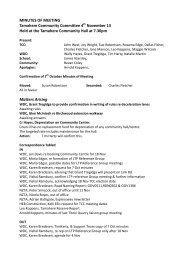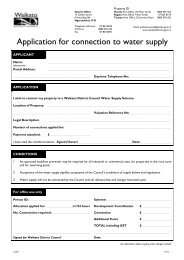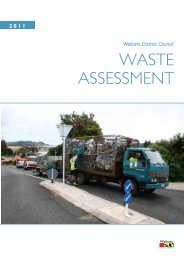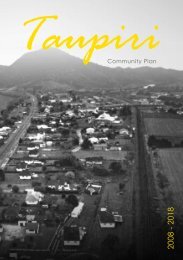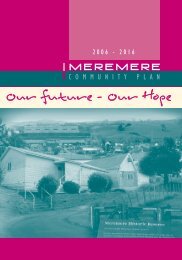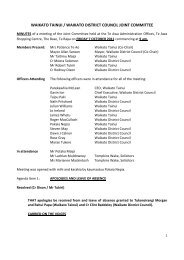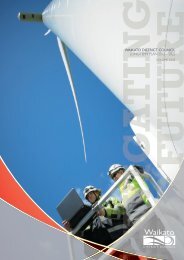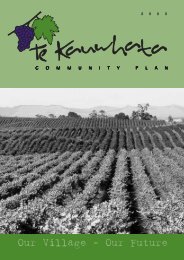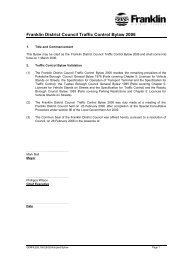Franklin Plus 2010 - Waikato District Council
Franklin Plus 2010 - Waikato District Council
Franklin Plus 2010 - Waikato District Council
Create successful ePaper yourself
Turn your PDF publications into a flip-book with our unique Google optimized e-Paper software.
<strong>Franklin</strong> <strong>Plus</strong> <strong>2010</strong><br />
A Development Strategy for a Rural-Based Economy<br />
The strategy’s aim<br />
is to achieve:<br />
“an innovative, sustainable<br />
and growth oriented rural<br />
economy”.<br />
VOLUME 1
Strategic Aim<br />
The strategy’s aim is to achieve:<br />
“an innovative, sustainable and growth oriented rural economy”.<br />
This will build upon the already flourishing rural-based economy of <strong>Franklin</strong>,<br />
its competitive and locational advantages and environmental attributes.<br />
The three areas of focus are:<br />
A regulatory environment that enables growth and innovation across the key<br />
rural sectors.<br />
Investment in infrastructure and initiatives that support and stimulate<br />
economic growth.<br />
To advocate for the provision of services and infrastructure that promote<br />
economic growth.<br />
The strategy will:<br />
• Provide key directions to the Auckland, <strong>Waikato</strong> and Hauraki <strong>Council</strong>s for<br />
promoting economic growth.<br />
• Inform the Long Term <strong>Council</strong> Community Plans, Annual Plans and Strategy<br />
and Policy documents of all the above three councils.<br />
• Provide direction to <strong>District</strong> Plan development and reviews.<br />
• Contribute to the Auckland <strong>Council</strong> Spatial Plan.<br />
FRANKLIN PLUS <strong>2010</strong> - A DEVELOPMENT STRATEGY FOR A RURAL-BASED ECONOMY - VOLUME 1<br />
1
Introduction<br />
The <strong>Franklin</strong> <strong>District</strong> is primarily a rural district with a substantial area of rural<br />
land, supported by towns and villages. It therefore has a rural-based economy,<br />
with particular location and competitive advantages.<br />
<strong>Council</strong> has formulated a development strategy to capitalise on these advantages,<br />
to achieve “an innovative, sustainable and growth oriented rural<br />
economy”.<br />
The strategy is divided into two volumes. This volume (volume 1) is a<br />
snapshot of <strong>Franklin</strong>’s rural-based economy, its current direction and factors<br />
that are needed for growth through the eyes of those at the “coal face” – the<br />
rural operators. Volume 2 gives more detailed information, with supporting<br />
statistics.<br />
From this comes a list of key actions to help further build on the strengths<br />
and remove constraints to the growth of <strong>Franklin</strong>’s economy.<br />
Due to the changes to Auckland governance, in November <strong>2010</strong>, governance<br />
of the <strong>Franklin</strong> <strong>District</strong> will be split between the Auckland, <strong>Waikato</strong> and<br />
Hauraki <strong>Council</strong>s. The target audience for this strategy is therefore these<br />
successor councils, including <strong>Franklin</strong> Local Board members, and other<br />
economic and social stakeholders.<br />
The strategy is an advocacy document for the future of rural <strong>Franklin</strong>.<br />
It will provide a platform for future stakeholders to further develop an already<br />
flourishing economy.<br />
For more detailed information, check the main strategy document (volume 2).<br />
This is available at www.franklin.govt.nz or by calling 09 237 1300.<br />
FRANKLIN PLUS <strong>2010</strong> - A DEVELOPMENT STRATEGY FOR A RURAL-BASED ECONOMY - VOLUME 1<br />
2
So where are we now<br />
The <strong>Franklin</strong> <strong>District</strong> is extensively rural, with 88% of land zoned for rural<br />
activities. The economy is supported by towns and villages, with high levels<br />
of retail and service sector growth.<br />
A large proportion of New Zealand’s vegetables are produced in the <strong>District</strong>,<br />
with a tradition of field crops, such as onions and potatoes. Exports of horticultural<br />
products were estimated at 88% of the <strong>District</strong>’s total horticultural<br />
sales in 2006.<br />
The <strong>District</strong>’s population is growing at a rapid rate, with a 14% increase<br />
between 2001 and 2006, reaching 58,900 in 2006. It has a youthful population,<br />
with 31% of the population under 20 years.<br />
Agricultural and horticultural activities provide 13.1% of employment. Manufacturing<br />
is also significant in the rural area, dominated by the presence of<br />
the New Zealand Steel Mill.<br />
Key economic activities include:<br />
• Horticulture<br />
• Agriculture<br />
• Manufacturing<br />
• Equine<br />
• Tourism<br />
• Mineral Extraction<br />
Economic Development and Maori<br />
The Maori population makes up 14% of the total <strong>District</strong><br />
population. Maori economic interests and <strong>Franklin</strong>’s rural<br />
economy are interwoven, and many of the <strong>District</strong>’s workers<br />
are of Maori descent, some Tainui and some from other<br />
Iwi.<br />
Tainui iwi have negotiated Treaty claims, including those<br />
applying to the <strong>Waikato</strong> River. It is expected that the<br />
outcomes of those settlements will lead to Tainui becoming<br />
increasingly involved in economic and social development<br />
initiatives as investors and as resource management<br />
stakeholders.<br />
All persons exercising the functions and powers of the<br />
Resource Management Act must have regard to kaitiakitanga<br />
(guardianship), the principles of the Treaty of Waitangi<br />
and the protection of historic heritage from inappropriate<br />
subdivision, use and development. In planning for<br />
economic development, within the <strong>District</strong> Planning framework,<br />
these principles must be taken into consideration.<br />
A considerable level of economic activity is focused in the northern part of the<br />
<strong>District</strong>. In this area, the land is versatile, supporting towns are well established<br />
and there are good connections to the surrounding regions.<br />
FRANKLIN PLUS <strong>2010</strong> - A DEVELOPMENT STRATEGY FOR A RURAL-BASED ECONOMY - VOLUME 1<br />
3
So where are we now<br />
<strong>Council</strong>’s Strategic Direction<br />
<strong>District</strong> Growth<br />
Strategy<br />
Strategies and Plans:<br />
• Transport<br />
• Heritage<br />
• Economic Development<br />
• Social Wellbeing<br />
• Growth and Innovation<br />
Framework<br />
Long Term <strong>Council</strong><br />
Community Plan<br />
Resource<br />
Management Act<br />
Documents<br />
Policies<br />
and Bylaws<br />
Asset Management<br />
Plans<br />
• <strong>District</strong> Plan<br />
• Plan Changes<br />
• Pukekohe Futures<br />
• Pukekohe Concept Plan<br />
There are several <strong>Council</strong> documents and plans that are linked to or influence the <strong>District</strong>’s rural economy.<br />
Those with significant influence are examined in more detail in Volume 2<br />
FRANKLIN PLUS <strong>2010</strong> - A DEVELOPMENT STRATEGY FOR A RURAL-BASED ECONOMY - VOLUME 1<br />
4
So where are we now<br />
Urban and Regional Influences<br />
<strong>Franklin</strong>’s economy is dominated by activities related to agriculture or land<br />
resources. The proximity of the Auckland urban area directly influences this<br />
economy in both a positive and negative way. To a lesser degree, the <strong>Waikato</strong><br />
region provides both a domestic market and scientific services, particularly<br />
for horticulture.<br />
Negative influences on these areas include:<br />
• Land prices and competition for land<br />
• Fragmentation of land<br />
• Rural character expectations<br />
• Environmental demands<br />
• Impacts of expansion on equine hub<br />
• Lack of public transport to and from the <strong>District</strong>.<br />
<strong>Franklin</strong>’s towns and villages provide significant services that underpin rural<br />
productivity and are an important component of the <strong>District</strong> identity.<br />
The towns and villages developed as service centres for the rural area. In<br />
some cases, these settlements include particular rural service features such<br />
as the A&P showgrounds in Pukekohe and the saleyards in Pukekohe and<br />
Tuakau.<br />
The larger towns provide a base for businesses manufacturing and processing<br />
rural products, adding value to raw materials before they are exported to<br />
Auckland and further afield. In addition to the provision of business land in<br />
Pukekohe, a number of zoning initiatives for new industrial zones in Tuakau,<br />
Waiuku and Pokeno provide a basis for encouraging new rural suppliers/<br />
service industries and possible distribution/processing hubs.<br />
Positive influences include:<br />
• Extent of the domestic market and proximity to Auckland market<br />
• Supporting infrastructure (place in the “golden economic triangle” of<br />
Hamilton, Auckland and Tauranga)<br />
• Transport accessibility and freight movement<br />
• Employment base<br />
• Growth in key settlements<br />
• Tourism and visitors<br />
• Agricultural support sector and industrial land<br />
These are discussed in more detail in volume 2.<br />
FRANKLIN PLUS <strong>2010</strong> - A DEVELOPMENT STRATEGY FOR A RURAL-BASED ECONOMY - VOLUME 1<br />
5
So where are we now<br />
Expected growth sectors are:<br />
• Horticulture and value added<br />
• Manufacturing<br />
• Equine<br />
• Mineral extraction<br />
• Tourism<br />
• Motorsport<br />
Interviews with key sector operators identified current issues and what is<br />
needed from <strong>Council</strong> for these businesses to grow.<br />
Some of the actual and potential issues common to all these sectors<br />
include:<br />
Specific sector issues include:<br />
• To meet market needs, horticultural operations are changing. They need<br />
to use specialised on-site packaging and production methods. This is<br />
constrained by current planning rules.<br />
• Further development of equine hubs and links between equine establishments<br />
is needed.<br />
• Reverse sensitivity issues from local residents around manufacturing and<br />
mining operations in rural areas cause problems for these sectors.<br />
• There is a need for a co-ordinated local and regional tourism promotion<br />
and more provision for tourism activities in planning documents.<br />
• Conflicts with the perception of the rural environment as just a clean/green<br />
landscape rather than also a working environment (noise, dust)<br />
• Fragmentation of rural land and lack of suitable sized properties for rural<br />
production<br />
• High land costs<br />
• Competition for water supply from aquifers for horticulture and agriculture<br />
in the northern area<br />
• Importance of transport links<br />
• Perceived inconsistency in <strong>Council</strong>’s planning rules and lack of knowledge<br />
of rural sector.<br />
FRANKLIN PLUS <strong>2010</strong> - A DEVELOPMENT STRATEGY FOR A RURAL-BASED ECONOMY - VOLUME 1<br />
6
Where do we want to be<br />
Vision and Mission<br />
The <strong>District</strong>’s vision statement is:<br />
“A country lifestyle in harmony with our environment”.<br />
The <strong>District</strong>’s mission statement is:<br />
“A diverse people living within defined, planned and serviced country towns<br />
and villages surrounded by countryside offering great living, working and<br />
recreational options, connected to cities by well developed transport links”.<br />
The importance of a countryside environment comes through strongly in<br />
these statements, with a clear distinction between the settlements and the<br />
surrounding countryside. These statements have been used to set the guiding<br />
principles for this and other <strong>Council</strong> strategies.<br />
The Enterprise <strong>Franklin</strong> Development Trust (EFDT) currently operates in<br />
partnership with <strong>Council</strong> to foster, influence and initiate economic development<br />
in <strong>Franklin</strong>. EFDT are champions and custodians of the Economic<br />
Growth and Innovation Framework. However, this relationship will change<br />
under the revision of Auckland governance arrangements.<br />
The principles identified in the Framework are to:<br />
• retain existing wealth,<br />
• create new wealth, and<br />
• capture wealth from elsewhere.<br />
These principles are used by both EFDT and <strong>Council</strong> to foster and facilitate<br />
economic growth. These are expected to remain as principles in future<br />
economic planning for the <strong>District</strong>.<br />
Economic Growth Framework<br />
The Economic Growth and Innovation Framework sets the foundations for<br />
the <strong>District</strong>’s future economic and employment growth. The Framework<br />
identifies four high growth sectors in the <strong>District</strong>. These are horticulture,<br />
construction, steel production and visitor experiences.<br />
Clustered around these ‘driver sectors’ are ‘complementary activity sectors’<br />
to be developed and grown to support the key sectors.<br />
FRANKLIN PLUS <strong>2010</strong> - A DEVELOPMENT STRATEGY FOR A RURAL-BASED ECONOMY - VOLUME 1<br />
7
Where do we want to be<br />
<strong>District</strong> Growth Strategy<br />
One of the main concerns in the <strong>District</strong> is the increasing fragmentation of<br />
land and loss of rural character. The creation of rural lifestyle has the potential<br />
to inefficiently use good quality, productive land, and can also damage<br />
the rural character that attracts rural lifestylers in the first place. There are<br />
also reverse sensitivity issues, increased car movements, demands for wider<br />
roads and negative effects on the landscape.<br />
<strong>Council</strong> has developed a <strong>District</strong> Growth Strategy (DGS) which recommends<br />
that future growth is accommodated through redevelopment in existing<br />
urban areas, particularly in the three main towns of Pukekohe, Waiuku and<br />
Tuakau, and also in the growth nodes of Pokeno and Kingseat. In addition,<br />
it provides for greenfield development in selected places and rural living in<br />
defined locations.<br />
Integrated Transport Strategy<br />
The Integrated Transport Strategy gives guiding principles and objectives<br />
which inform and guide the long term development of safe and easy transport<br />
in the <strong>District</strong>. More specific and immediate actions over the next 3-9<br />
years are given in six action plans which complement the Strategy, including<br />
a Freight Action Plan and Passenger Transport Advocacy Plan.<br />
The Freight Transport Plan identifies how <strong>Council</strong> intends to facilitate freight<br />
movement to support the growth and development of <strong>Franklin</strong> as signalled by<br />
the DGS and Auckland regional plans. The Plan:<br />
• Recognises that freight movement is one element of the land use/transport<br />
equation, and needs to be developed to support growth.<br />
• Recognises that road freight will be the principal method of freight movement<br />
for the foreseeable future, and needs to be integrated with rail,<br />
regional air and sea freight.<br />
• Identifies an efficient road freight network as a basis for capital and maintenance<br />
infrastructure investment.<br />
The Passenger Transport Advocacy Plan promotes the development of public<br />
transport to support the towns and rural areas.<br />
FRANKLIN PLUS <strong>2010</strong> - A DEVELOPMENT STRATEGY FOR A RURAL-BASED ECONOMY - VOLUME 1<br />
8
How do we get there<br />
To create “an innovative, sustainable and growth<br />
oriented rural economy” the following objectives are<br />
recommended:<br />
Provide a regulatory environment that enables growth and innovation<br />
across the key rural sectors.<br />
• Allow complementary, multiple and value-added rural economic activities<br />
to occur on one site.<br />
• Create growth sectors around key economic clusters of horticulture,<br />
equine, manufacturing and tourism.<br />
• Encourage larger land holdings and address level of fragmentation.<br />
• Protect the <strong>District</strong>’s mineral resources for future use.<br />
• Make adequate industrial land available for rural support industries<br />
• Provide a <strong>District</strong> roading network that facilitates the movement of freight<br />
to and from rural economic activities.<br />
• Promote recognition of Maori values and needs.<br />
• Provide an allocation regime to ensure the availability of water to meet the<br />
present and future needs of rural economic activities.<br />
• Promote a wider understanding of rural character in planning documents.<br />
FRANKLIN PLUS <strong>2010</strong> - A DEVELOPMENT STRATEGY FOR A RURAL-BASED ECONOMY - VOLUME 1<br />
9
How do we get there<br />
Invest in infrastructure and initiatives that support and stimulate<br />
economic growth.<br />
• Provide infrastructure that attracts and retains key economic activities<br />
and a skilled workforce.<br />
• Invest in economic initiatives and partnerships.<br />
• Invest in productive and vibrant town centres.<br />
• Retain and build upon existing sites with an urban/rural connection,<br />
e.g. A&P Showgrounds.<br />
Influence and advocate for services and infrastructure promoting<br />
economic growth.<br />
• Influence investment in nationally owned infrastructure, in particular:<br />
- Passenger transport<br />
- Broadband<br />
- Rail<br />
- Water supply.<br />
• Support and promote regional and national complementary economic<br />
initiatives.<br />
• Promote economic growth by continuous review of the <strong>District</strong> Plan<br />
rules.<br />
• Provide a responsive and knowledgeable service to customers.<br />
FRANKLIN PLUS <strong>2010</strong> - A DEVELOPMENT STRATEGY FOR A RURAL-BASED ECONOMY - VOLUME 1<br />
10
How do we get there<br />
An indicative spatial plan for <strong>Franklin</strong> is shown below<br />
Synergies with other<br />
rural areas<br />
High quality Coastal<br />
Environment - Tourism and<br />
Farming<br />
Steel Mill<br />
Equine<br />
Equine<br />
Coastal<br />
ecology - aquaculture<br />
- farming<br />
Agricultural- horticultural<br />
economic development and<br />
innovation preference<br />
Transport and Distribution<br />
opportunities area<br />
Northern <strong>Waikato</strong><br />
gateway<br />
Key service centres<br />
Rural activity /industry hub<br />
<strong>Franklin</strong> <strong>Plus</strong> <strong>2010</strong> indicative spatial plan directions should be incorporated<br />
into the Auckland Spatial Plan and key strategic documents for <strong>Waikato</strong> and<br />
Hauraki <strong>Council</strong>s. This will highlight <strong>Franklin</strong>’s role in the wider economy,<br />
giving impetus to economic growth.<br />
For more detailed information, check the main strategy document (volume 2).<br />
This is available at www.franklin.govt.nz or by calling 09 237 1300.<br />
FRANKLIN PLUS <strong>2010</strong> - A DEVELOPMENT STRATEGY FOR A RURAL-BASED ECONOMY - VOLUME 1<br />
11



